Pitching and Negotiation Skills: HND Business, Nelson College London
VerifiedAdded on 2023/06/10
|9
|2179
|182
Report
AI Summary
This report provides an overview of pitching and negotiation skills, focusing on their importance in business development, particularly in securing contracts. It defines negotiation, identifies key stakeholders such as competitors, suppliers, and customers, and outlines the essential steps in the negotiation process: preparation, information exchange, clarification, bargaining, and conclusion. The report also discusses the RFP (Request for Proposal) process, including requirements gathering, crafting the RFP, initial evaluation, and contract completion. Furthermore, it details the contractual process, emphasizing contract preparation, authorization, negotiation, appraisal, and execution. The document concludes by highlighting the significance of negotiation in reaching mutually beneficial agreements and the importance of effective pitching in attracting customers. The report also briefly touches upon the potential consequences of breaching contract terms and notes that additional content is available in an accompanying PowerPoint presentation. This assignment was completed for the HND Business course at Nelson College London.

Pitching and
negotiation skills
negotiation skills
Paraphrase This Document
Need a fresh take? Get an instant paraphrase of this document with our AI Paraphraser
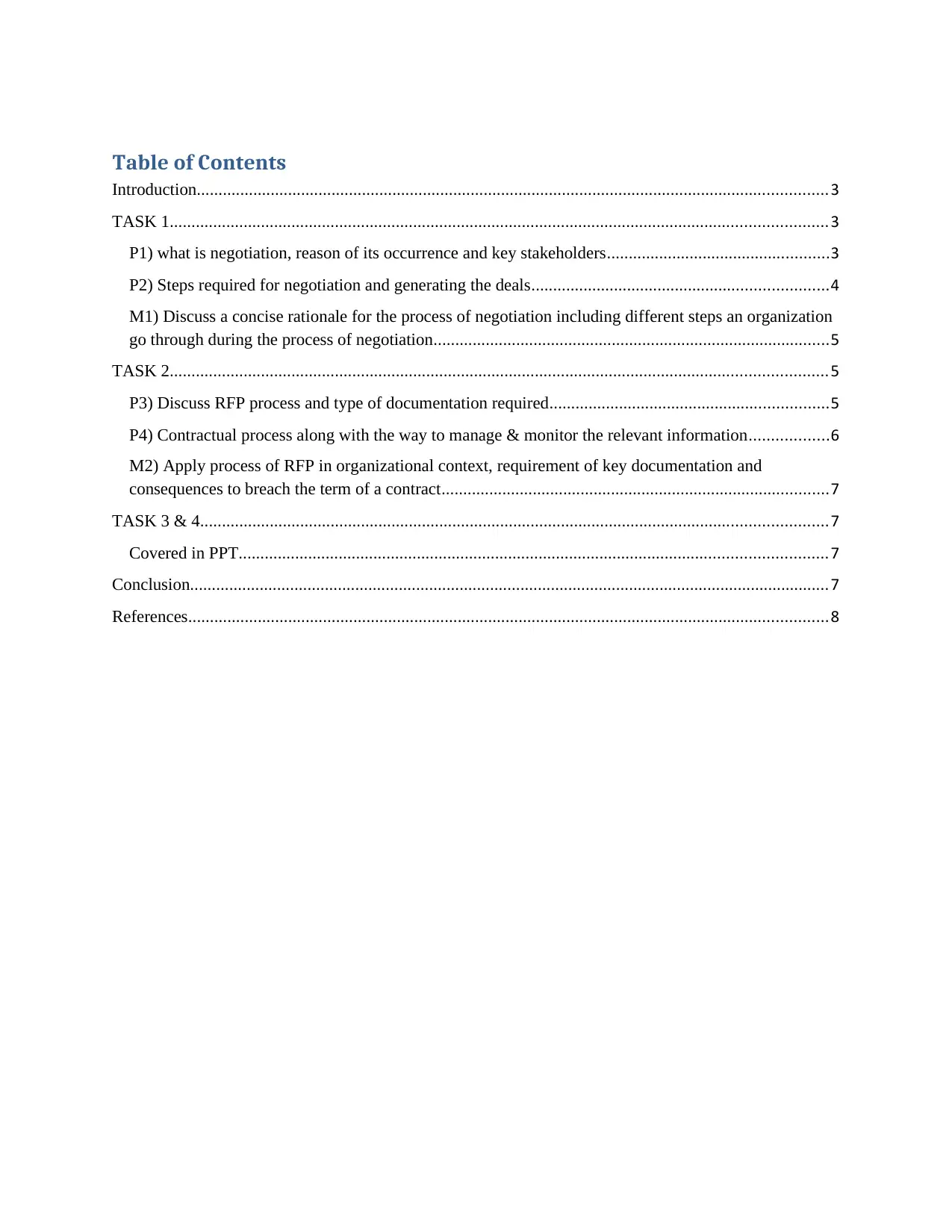
Table of Contents
Introduction.................................................................................................................................................3
TASK 1.......................................................................................................................................................3
P1) what is negotiation, reason of its occurrence and key stakeholders...................................................3
P2) Steps required for negotiation and generating the deals....................................................................4
M1) Discuss a concise rationale for the process of negotiation including different steps an organization
go through during the process of negotiation...........................................................................................5
TASK 2.......................................................................................................................................................5
P3) Discuss RFP process and type of documentation required................................................................5
P4) Contractual process along with the way to manage & monitor the relevant information..................6
M2) Apply process of RFP in organizational context, requirement of key documentation and
consequences to breach the term of a contract.........................................................................................7
TASK 3 & 4................................................................................................................................................7
Covered in PPT.......................................................................................................................................7
Conclusion...................................................................................................................................................7
References...................................................................................................................................................8
Introduction.................................................................................................................................................3
TASK 1.......................................................................................................................................................3
P1) what is negotiation, reason of its occurrence and key stakeholders...................................................3
P2) Steps required for negotiation and generating the deals....................................................................4
M1) Discuss a concise rationale for the process of negotiation including different steps an organization
go through during the process of negotiation...........................................................................................5
TASK 2.......................................................................................................................................................5
P3) Discuss RFP process and type of documentation required................................................................5
P4) Contractual process along with the way to manage & monitor the relevant information..................6
M2) Apply process of RFP in organizational context, requirement of key documentation and
consequences to breach the term of a contract.........................................................................................7
TASK 3 & 4................................................................................................................................................7
Covered in PPT.......................................................................................................................................7
Conclusion...................................................................................................................................................7
References...................................................................................................................................................8
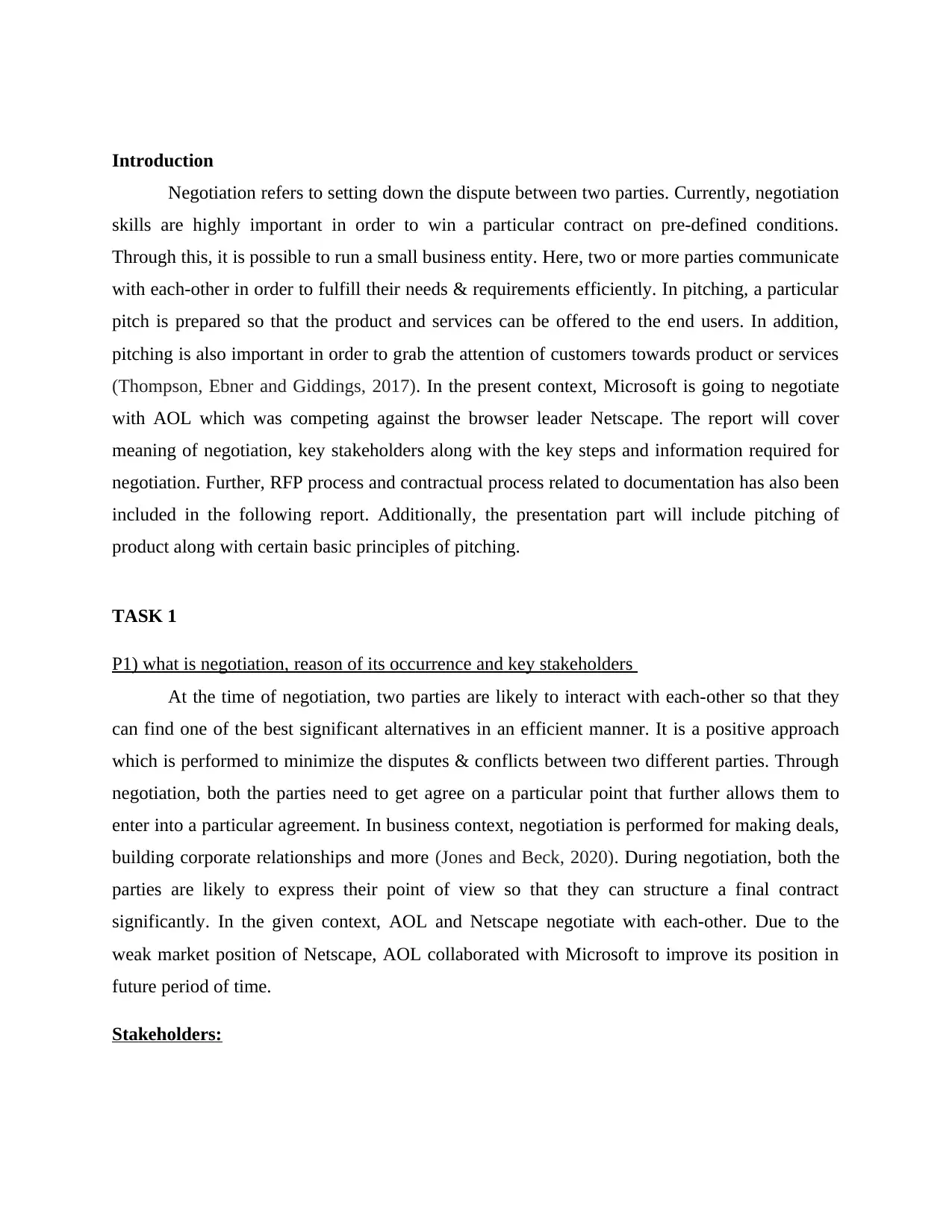
Introduction
Negotiation refers to setting down the dispute between two parties. Currently, negotiation
skills are highly important in order to win a particular contract on pre-defined conditions.
Through this, it is possible to run a small business entity. Here, two or more parties communicate
with each-other in order to fulfill their needs & requirements efficiently. In pitching, a particular
pitch is prepared so that the product and services can be offered to the end users. In addition,
pitching is also important in order to grab the attention of customers towards product or services
(Thompson, Ebner and Giddings, 2017). In the present context, Microsoft is going to negotiate
with AOL which was competing against the browser leader Netscape. The report will cover
meaning of negotiation, key stakeholders along with the key steps and information required for
negotiation. Further, RFP process and contractual process related to documentation has also been
included in the following report. Additionally, the presentation part will include pitching of
product along with certain basic principles of pitching.
TASK 1
P1) what is negotiation, reason of its occurrence and key stakeholders
At the time of negotiation, two parties are likely to interact with each-other so that they
can find one of the best significant alternatives in an efficient manner. It is a positive approach
which is performed to minimize the disputes & conflicts between two different parties. Through
negotiation, both the parties need to get agree on a particular point that further allows them to
enter into a particular agreement. In business context, negotiation is performed for making deals,
building corporate relationships and more (Jones and Beck, 2020). During negotiation, both the
parties are likely to express their point of view so that they can structure a final contract
significantly. In the given context, AOL and Netscape negotiate with each-other. Due to the
weak market position of Netscape, AOL collaborated with Microsoft to improve its position in
future period of time.
Stakeholders:
Negotiation refers to setting down the dispute between two parties. Currently, negotiation
skills are highly important in order to win a particular contract on pre-defined conditions.
Through this, it is possible to run a small business entity. Here, two or more parties communicate
with each-other in order to fulfill their needs & requirements efficiently. In pitching, a particular
pitch is prepared so that the product and services can be offered to the end users. In addition,
pitching is also important in order to grab the attention of customers towards product or services
(Thompson, Ebner and Giddings, 2017). In the present context, Microsoft is going to negotiate
with AOL which was competing against the browser leader Netscape. The report will cover
meaning of negotiation, key stakeholders along with the key steps and information required for
negotiation. Further, RFP process and contractual process related to documentation has also been
included in the following report. Additionally, the presentation part will include pitching of
product along with certain basic principles of pitching.
TASK 1
P1) what is negotiation, reason of its occurrence and key stakeholders
At the time of negotiation, two parties are likely to interact with each-other so that they
can find one of the best significant alternatives in an efficient manner. It is a positive approach
which is performed to minimize the disputes & conflicts between two different parties. Through
negotiation, both the parties need to get agree on a particular point that further allows them to
enter into a particular agreement. In business context, negotiation is performed for making deals,
building corporate relationships and more (Jones and Beck, 2020). During negotiation, both the
parties are likely to express their point of view so that they can structure a final contract
significantly. In the given context, AOL and Netscape negotiate with each-other. Due to the
weak market position of Netscape, AOL collaborated with Microsoft to improve its position in
future period of time.
Stakeholders:
⊘ This is a preview!⊘
Do you want full access?
Subscribe today to unlock all pages.

Trusted by 1+ million students worldwide

Competitors: It is monitored that competitors are significant stakeholder of business.
They have potential to affect the business function. Sometimes, companies are likely to negotiate
with its competitors in order to structure a particular agreement.
Suppliers: Suppliers are also considered as one of the significant stakeholders of
business as they used to supply necessary raw material and other products. To get the goods at
reasonable price, companies are likely to negotiate with their suppliers so that they can get raw
material at appropriate rate.
Customers: Customers are also important stakeholders. They are likely to negotiate with
retailers with an aim to get best quality products at reasonable price (Wheadon and Duval‐
Couetil, 2019).
P2) Steps required for negotiation and generating the deals
Negotiation is a crucial process that is helpful in structuring a suitable contract in
significant manner. In this regard, the steps of negotiation are mentioned below:
Prepare: At this stage, both parties are likely to get involve in discussion with each-
other. Identifying trade offs, determining high as well as least desired outcomes is important to
make the overall discussion effective. Also, there is requirement to prepare a list of such points
which are going to discuss during the meeting.
Exchange information: In this, both the parties exchange the information they have. To
achieve desired results from the negotiation process, each part is likely to share own interest,
aims, concerns and more (Vecchi and et. al., 2019). Also, they need to maintain the
communication regarding the end result of negotiation process.
Clarify: After exchanging information, both the parties are required to put their claims
and give proper justification for such claims. Here, it is possible that one party got agree on a
particular point where the other one is not. In this situation, it is imperative to deal with the
disagreements through discussion.
Bargain and problem solve: Under this, both the parties start to bargain with each-other.
Here, they provide counter offer. Emotion needs to be control while getting involve in bargaining
They have potential to affect the business function. Sometimes, companies are likely to negotiate
with its competitors in order to structure a particular agreement.
Suppliers: Suppliers are also considered as one of the significant stakeholders of
business as they used to supply necessary raw material and other products. To get the goods at
reasonable price, companies are likely to negotiate with their suppliers so that they can get raw
material at appropriate rate.
Customers: Customers are also important stakeholders. They are likely to negotiate with
retailers with an aim to get best quality products at reasonable price (Wheadon and Duval‐
Couetil, 2019).
P2) Steps required for negotiation and generating the deals
Negotiation is a crucial process that is helpful in structuring a suitable contract in
significant manner. In this regard, the steps of negotiation are mentioned below:
Prepare: At this stage, both parties are likely to get involve in discussion with each-
other. Identifying trade offs, determining high as well as least desired outcomes is important to
make the overall discussion effective. Also, there is requirement to prepare a list of such points
which are going to discuss during the meeting.
Exchange information: In this, both the parties exchange the information they have. To
achieve desired results from the negotiation process, each part is likely to share own interest,
aims, concerns and more (Vecchi and et. al., 2019). Also, they need to maintain the
communication regarding the end result of negotiation process.
Clarify: After exchanging information, both the parties are required to put their claims
and give proper justification for such claims. Here, it is possible that one party got agree on a
particular point where the other one is not. In this situation, it is imperative to deal with the
disagreements through discussion.
Bargain and problem solve: Under this, both the parties start to bargain with each-other.
Here, they provide counter offer. Emotion needs to be control while getting involve in bargaining
Paraphrase This Document
Need a fresh take? Get an instant paraphrase of this document with our AI Paraphraser
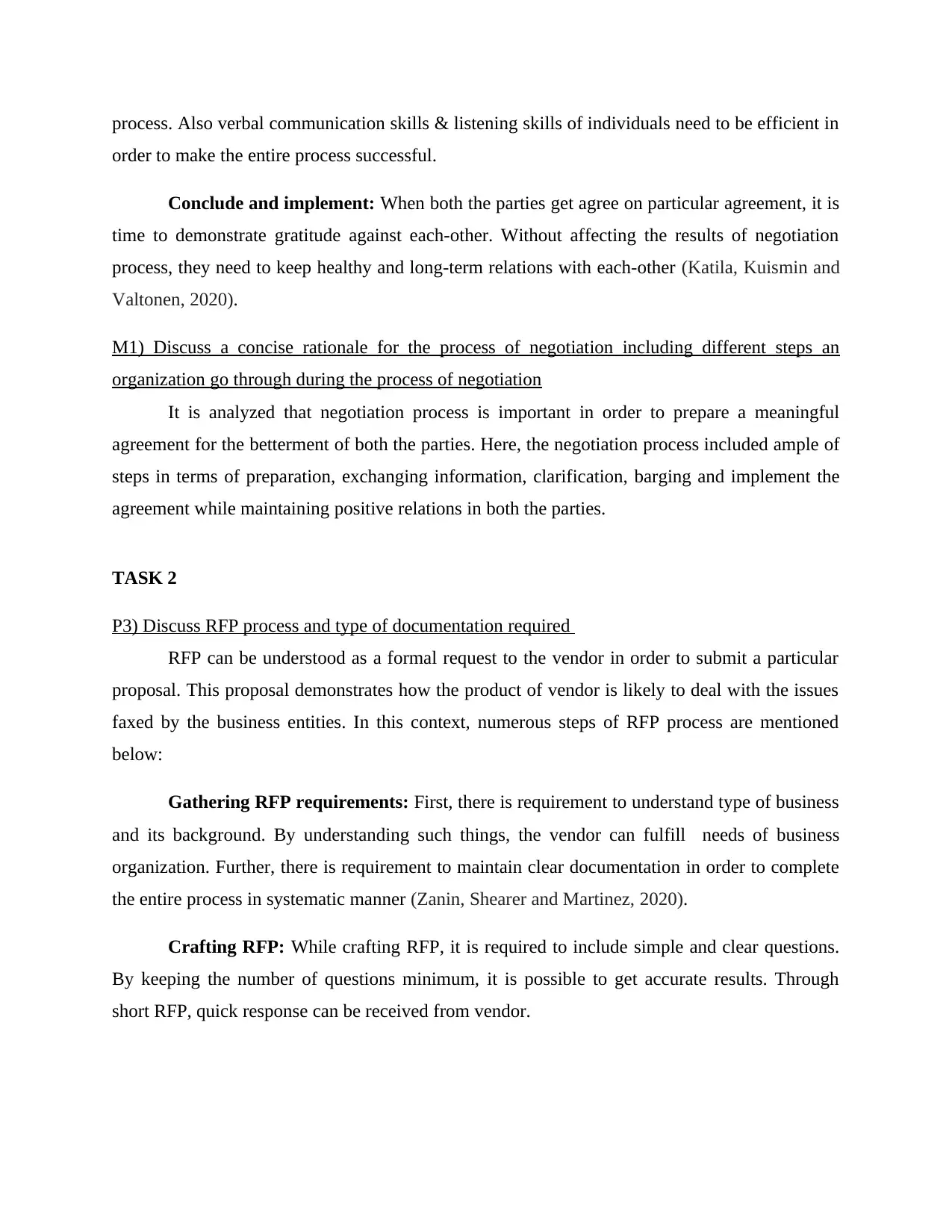
process. Also verbal communication skills & listening skills of individuals need to be efficient in
order to make the entire process successful.
Conclude and implement: When both the parties get agree on particular agreement, it is
time to demonstrate gratitude against each-other. Without affecting the results of negotiation
process, they need to keep healthy and long-term relations with each-other (Katila, Kuismin and
Valtonen, 2020).
M1) Discuss a concise rationale for the process of negotiation including different steps an
organization go through during the process of negotiation
It is analyzed that negotiation process is important in order to prepare a meaningful
agreement for the betterment of both the parties. Here, the negotiation process included ample of
steps in terms of preparation, exchanging information, clarification, barging and implement the
agreement while maintaining positive relations in both the parties.
TASK 2
P3) Discuss RFP process and type of documentation required
RFP can be understood as a formal request to the vendor in order to submit a particular
proposal. This proposal demonstrates how the product of vendor is likely to deal with the issues
faxed by the business entities. In this context, numerous steps of RFP process are mentioned
below:
Gathering RFP requirements: First, there is requirement to understand type of business
and its background. By understanding such things, the vendor can fulfill needs of business
organization. Further, there is requirement to maintain clear documentation in order to complete
the entire process in systematic manner (Zanin, Shearer and Martinez, 2020).
Crafting RFP: While crafting RFP, it is required to include simple and clear questions.
By keeping the number of questions minimum, it is possible to get accurate results. Through
short RFP, quick response can be received from vendor.
order to make the entire process successful.
Conclude and implement: When both the parties get agree on particular agreement, it is
time to demonstrate gratitude against each-other. Without affecting the results of negotiation
process, they need to keep healthy and long-term relations with each-other (Katila, Kuismin and
Valtonen, 2020).
M1) Discuss a concise rationale for the process of negotiation including different steps an
organization go through during the process of negotiation
It is analyzed that negotiation process is important in order to prepare a meaningful
agreement for the betterment of both the parties. Here, the negotiation process included ample of
steps in terms of preparation, exchanging information, clarification, barging and implement the
agreement while maintaining positive relations in both the parties.
TASK 2
P3) Discuss RFP process and type of documentation required
RFP can be understood as a formal request to the vendor in order to submit a particular
proposal. This proposal demonstrates how the product of vendor is likely to deal with the issues
faxed by the business entities. In this context, numerous steps of RFP process are mentioned
below:
Gathering RFP requirements: First, there is requirement to understand type of business
and its background. By understanding such things, the vendor can fulfill needs of business
organization. Further, there is requirement to maintain clear documentation in order to complete
the entire process in systematic manner (Zanin, Shearer and Martinez, 2020).
Crafting RFP: While crafting RFP, it is required to include simple and clear questions.
By keeping the number of questions minimum, it is possible to get accurate results. Through
short RFP, quick response can be received from vendor.
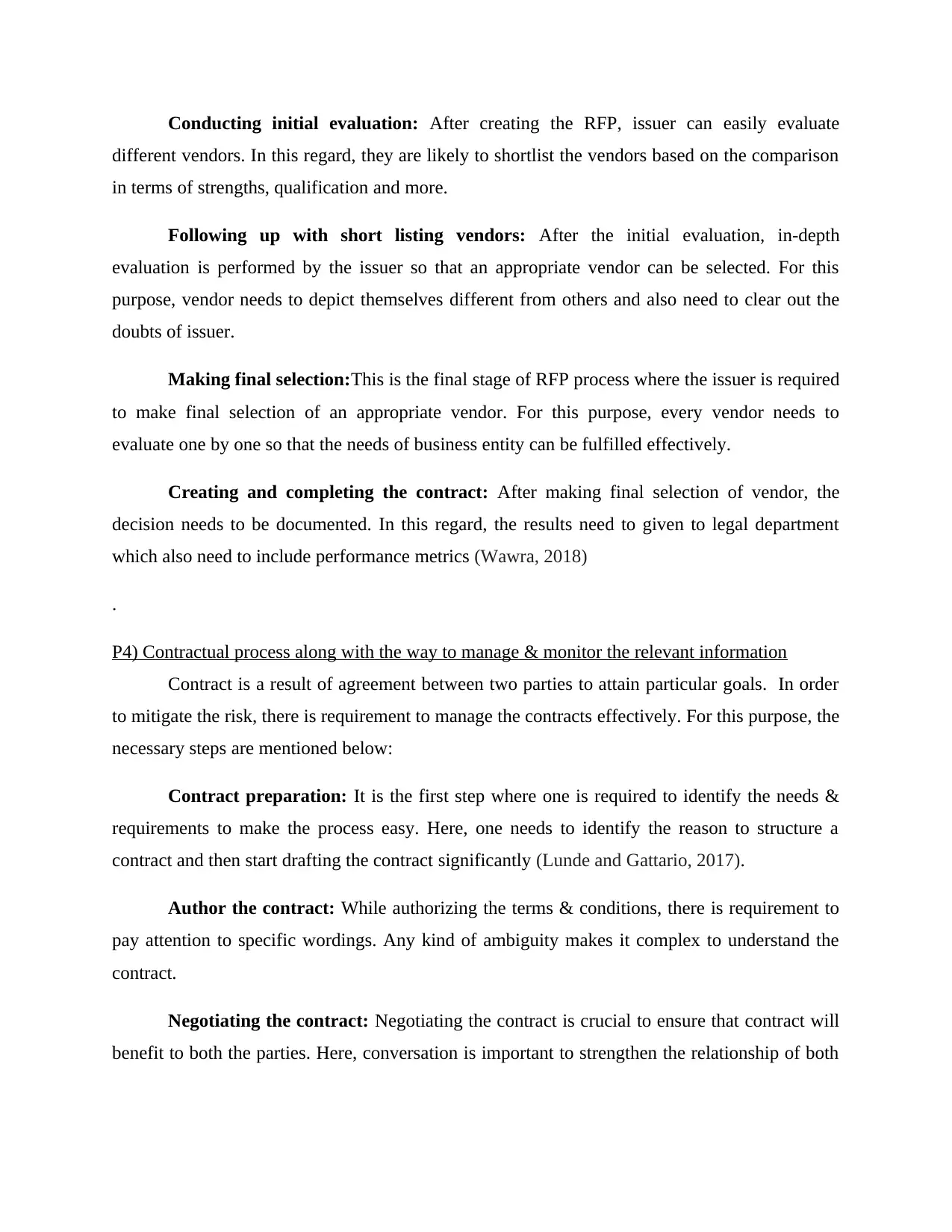
Conducting initial evaluation: After creating the RFP, issuer can easily evaluate
different vendors. In this regard, they are likely to shortlist the vendors based on the comparison
in terms of strengths, qualification and more.
Following up with short listing vendors: After the initial evaluation, in-depth
evaluation is performed by the issuer so that an appropriate vendor can be selected. For this
purpose, vendor needs to depict themselves different from others and also need to clear out the
doubts of issuer.
Making final selection:This is the final stage of RFP process where the issuer is required
to make final selection of an appropriate vendor. For this purpose, every vendor needs to
evaluate one by one so that the needs of business entity can be fulfilled effectively.
Creating and completing the contract: After making final selection of vendor, the
decision needs to be documented. In this regard, the results need to given to legal department
which also need to include performance metrics (Wawra, 2018)
.
P4) Contractual process along with the way to manage & monitor the relevant information
Contract is a result of agreement between two parties to attain particular goals. In order
to mitigate the risk, there is requirement to manage the contracts effectively. For this purpose, the
necessary steps are mentioned below:
Contract preparation: It is the first step where one is required to identify the needs &
requirements to make the process easy. Here, one needs to identify the reason to structure a
contract and then start drafting the contract significantly (Lunde and Gattario, 2017).
Author the contract: While authorizing the terms & conditions, there is requirement to
pay attention to specific wordings. Any kind of ambiguity makes it complex to understand the
contract.
Negotiating the contract: Negotiating the contract is crucial to ensure that contract will
benefit to both the parties. Here, conversation is important to strengthen the relationship of both
different vendors. In this regard, they are likely to shortlist the vendors based on the comparison
in terms of strengths, qualification and more.
Following up with short listing vendors: After the initial evaluation, in-depth
evaluation is performed by the issuer so that an appropriate vendor can be selected. For this
purpose, vendor needs to depict themselves different from others and also need to clear out the
doubts of issuer.
Making final selection:This is the final stage of RFP process where the issuer is required
to make final selection of an appropriate vendor. For this purpose, every vendor needs to
evaluate one by one so that the needs of business entity can be fulfilled effectively.
Creating and completing the contract: After making final selection of vendor, the
decision needs to be documented. In this regard, the results need to given to legal department
which also need to include performance metrics (Wawra, 2018)
.
P4) Contractual process along with the way to manage & monitor the relevant information
Contract is a result of agreement between two parties to attain particular goals. In order
to mitigate the risk, there is requirement to manage the contracts effectively. For this purpose, the
necessary steps are mentioned below:
Contract preparation: It is the first step where one is required to identify the needs &
requirements to make the process easy. Here, one needs to identify the reason to structure a
contract and then start drafting the contract significantly (Lunde and Gattario, 2017).
Author the contract: While authorizing the terms & conditions, there is requirement to
pay attention to specific wordings. Any kind of ambiguity makes it complex to understand the
contract.
Negotiating the contract: Negotiating the contract is crucial to ensure that contract will
benefit to both the parties. Here, conversation is important to strengthen the relationship of both
⊘ This is a preview!⊘
Do you want full access?
Subscribe today to unlock all pages.

Trusted by 1+ million students worldwide

the parties. For this purpose, a contract management system is prepared so that both the parties
can access their documents in significant manner.
Appraisal before finalizing: After getting agreement of both the parties, the next step is
taking approval. In large company, approval is taken by the manager. In contract management
procedure, it is quite simple to get the necessary approval by viewing the notification in real
time.
Execute the contract: At last, the contract needs to execute efficiently to get better
results in the future period of time. Both the parties make the contract official by signing it. Here,
signature can also be done online.
M2) Apply process of RFP in organizational context, requirement of key documentation and
consequences to breach the term of a contract
In context of RFP, there is a complete process including different steps such as gathering
requirements, crafting rfp, initial assessment, evaluation, final selection and more. It is monitored
that documentation is important in order to keep the records safely. It is found that breaching
terms of contract might have serious consequences in terms of fine, penalty, imprisonment and
more.
TASK 3 & 4
Covered in PPT
Conclusion
Out of the above-mentioned information, it is analyzed that negotiation refers the
interaction between two parties for the fulfillment of particular needs & requirements. Here,
negotiation is important in order to reach at meaningful conclusion in future period of time. It is
monitored that pitching is about providing necessary information to the customers regarding the
can access their documents in significant manner.
Appraisal before finalizing: After getting agreement of both the parties, the next step is
taking approval. In large company, approval is taken by the manager. In contract management
procedure, it is quite simple to get the necessary approval by viewing the notification in real
time.
Execute the contract: At last, the contract needs to execute efficiently to get better
results in the future period of time. Both the parties make the contract official by signing it. Here,
signature can also be done online.
M2) Apply process of RFP in organizational context, requirement of key documentation and
consequences to breach the term of a contract
In context of RFP, there is a complete process including different steps such as gathering
requirements, crafting rfp, initial assessment, evaluation, final selection and more. It is monitored
that documentation is important in order to keep the records safely. It is found that breaching
terms of contract might have serious consequences in terms of fine, penalty, imprisonment and
more.
TASK 3 & 4
Covered in PPT
Conclusion
Out of the above-mentioned information, it is analyzed that negotiation refers the
interaction between two parties for the fulfillment of particular needs & requirements. Here,
negotiation is important in order to reach at meaningful conclusion in future period of time. It is
monitored that pitching is about providing necessary information to the customers regarding the
Paraphrase This Document
Need a fresh take? Get an instant paraphrase of this document with our AI Paraphraser

products or service. Further, RFP process and process of contractual agreement have also been
discussed in the above report.
discussed in the above report.
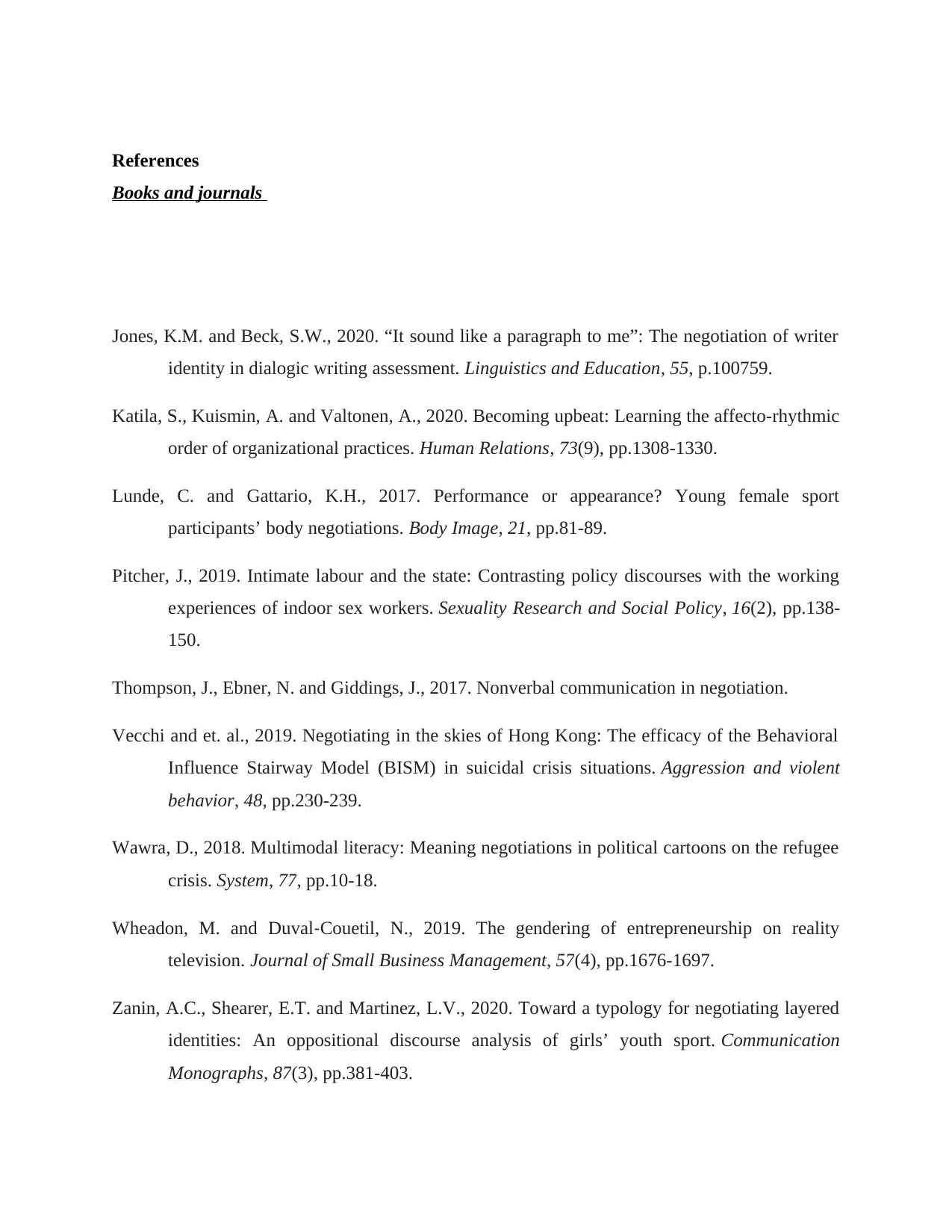
References
Books and journals
Jones, K.M. and Beck, S.W., 2020. “It sound like a paragraph to me”: The negotiation of writer
identity in dialogic writing assessment. Linguistics and Education, 55, p.100759.
Katila, S., Kuismin, A. and Valtonen, A., 2020. Becoming upbeat: Learning the affecto-rhythmic
order of organizational practices. Human Relations, 73(9), pp.1308-1330.
Lunde, C. and Gattario, K.H., 2017. Performance or appearance? Young female sport
participants’ body negotiations. Body Image, 21, pp.81-89.
Pitcher, J., 2019. Intimate labour and the state: Contrasting policy discourses with the working
experiences of indoor sex workers. Sexuality Research and Social Policy, 16(2), pp.138-
150.
Thompson, J., Ebner, N. and Giddings, J., 2017. Nonverbal communication in negotiation.
Vecchi and et. al., 2019. Negotiating in the skies of Hong Kong: The efficacy of the Behavioral
Influence Stairway Model (BISM) in suicidal crisis situations. Aggression and violent
behavior, 48, pp.230-239.
Wawra, D., 2018. Multimodal literacy: Meaning negotiations in political cartoons on the refugee
crisis. System, 77, pp.10-18.
Wheadon, M. and Duval‐Couetil, N., 2019. The gendering of entrepreneurship on reality
television. Journal of Small Business Management, 57(4), pp.1676-1697.
Zanin, A.C., Shearer, E.T. and Martinez, L.V., 2020. Toward a typology for negotiating layered
identities: An oppositional discourse analysis of girls’ youth sport. Communication
Monographs, 87(3), pp.381-403.
Books and journals
Jones, K.M. and Beck, S.W., 2020. “It sound like a paragraph to me”: The negotiation of writer
identity in dialogic writing assessment. Linguistics and Education, 55, p.100759.
Katila, S., Kuismin, A. and Valtonen, A., 2020. Becoming upbeat: Learning the affecto-rhythmic
order of organizational practices. Human Relations, 73(9), pp.1308-1330.
Lunde, C. and Gattario, K.H., 2017. Performance or appearance? Young female sport
participants’ body negotiations. Body Image, 21, pp.81-89.
Pitcher, J., 2019. Intimate labour and the state: Contrasting policy discourses with the working
experiences of indoor sex workers. Sexuality Research and Social Policy, 16(2), pp.138-
150.
Thompson, J., Ebner, N. and Giddings, J., 2017. Nonverbal communication in negotiation.
Vecchi and et. al., 2019. Negotiating in the skies of Hong Kong: The efficacy of the Behavioral
Influence Stairway Model (BISM) in suicidal crisis situations. Aggression and violent
behavior, 48, pp.230-239.
Wawra, D., 2018. Multimodal literacy: Meaning negotiations in political cartoons on the refugee
crisis. System, 77, pp.10-18.
Wheadon, M. and Duval‐Couetil, N., 2019. The gendering of entrepreneurship on reality
television. Journal of Small Business Management, 57(4), pp.1676-1697.
Zanin, A.C., Shearer, E.T. and Martinez, L.V., 2020. Toward a typology for negotiating layered
identities: An oppositional discourse analysis of girls’ youth sport. Communication
Monographs, 87(3), pp.381-403.
⊘ This is a preview!⊘
Do you want full access?
Subscribe today to unlock all pages.

Trusted by 1+ million students worldwide
1 out of 9
Related Documents
Your All-in-One AI-Powered Toolkit for Academic Success.
+13062052269
info@desklib.com
Available 24*7 on WhatsApp / Email
![[object Object]](/_next/static/media/star-bottom.7253800d.svg)
Unlock your academic potential
Copyright © 2020–2025 A2Z Services. All Rights Reserved. Developed and managed by ZUCOL.

